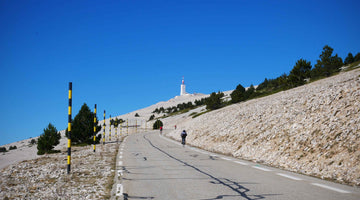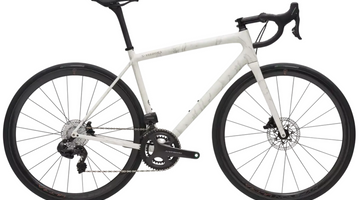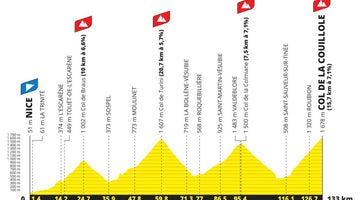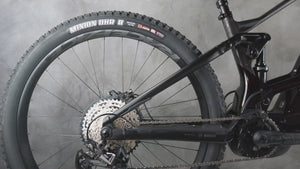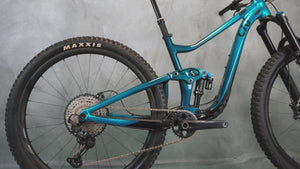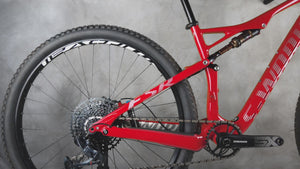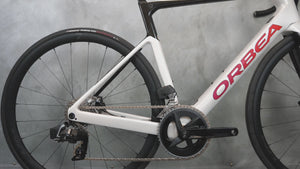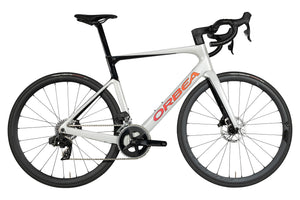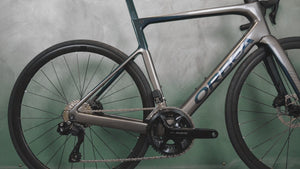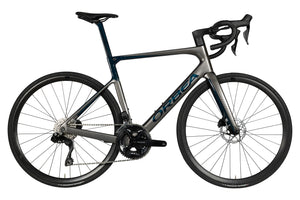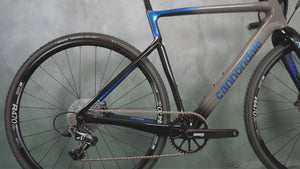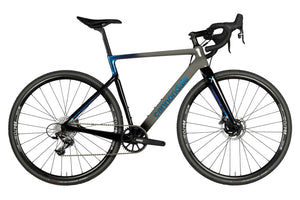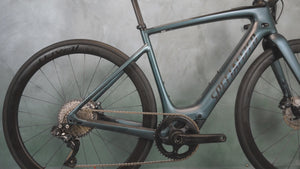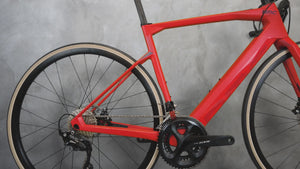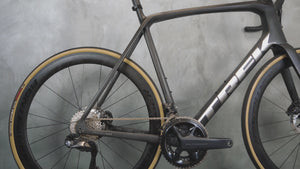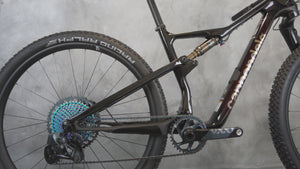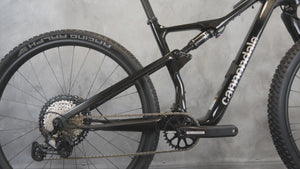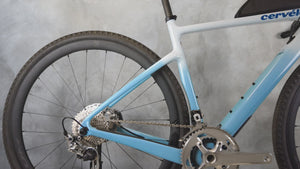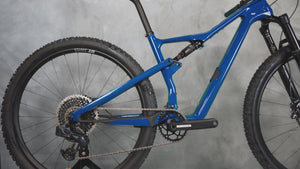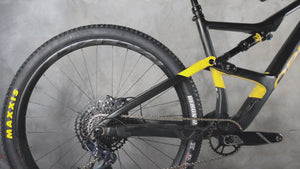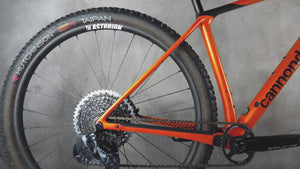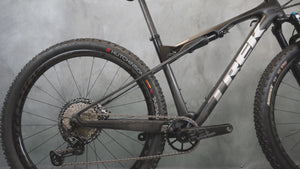How do you choose the right gear ratio?
In this Article
Published on 4 July 2024
Many cyclists wonder how to choose the right gear ratio. Unfortunately, there is no single answer. However, depending on whether you want a leisurely ride along the coast or the challenge of climbing the formidable Mont Ventoux, you can more easily determine the suitable gear ratio. Feeling lost? Don't worry, we'll try to break down this complex and somewhat unclear topic. How to choose your bike's gear ratio based on your practice? What size chainring teeth? Which cassette spacing to choose? Here is the essential information to make the right choice.

First, what is a gear ratio?
It's the relationship between the number of teeth on the chainring and the number on the cassette sprocket. For example, a 34 x 28 ratio indicates that you are using a chainring with 34 teeth and a sprocket with 28 teeth.
The road bike's gear ratio directly influences the distance covered with each pedal stroke. Depending on the terrain and your riding style, choosing the right gear is essential.

The gear ratio table
The gear ratio table provides an overview of the distances (in meters) that can be covered with the different gear ratios of a road bike equipped with 28-inch wheels. The vertical column on the left indicates the number of teeth on the chainring, while the top horizontal line shows the number of teeth on the rear sprocket. For example, a 39 x 25 ratio allows covering 3.33 meters per pedal stroke, while a 40 x 14 ratio covers 6.11 meters.

Thus, the number of teeth on the front and rear gears influences the distance covered. The table presents many figures, illustrating the variety of possible gear ratios. The choice of gear ratio depends on the type of chainring and cassette.
Rest assured, there's no need to memorize this complicated table. Let's get to the essentials!
Which crankset to choose?
The choice of the right crankset depends on the type of ride you plan and your training level. The crankset of your road bike is one of the most important parts. It consists of the chainrings and the crank arm. A crankset can have 1, 2, or rarely, 3 chainrings.
- Single chainring crankset: It can have between 38 and 50 teeth. This type of crankset is rare on a road bike, but it is particularly advantageous for off-road practices, such as MTB, gravel, or cyclo-cross.
- Double chainring crankset: It can consist of 50/34 teeth. We recommend opting for a double chainring crankset as it has many advantages.
Among double chainring cranksets, you can choose between a compact crankset (50/34), a semi-compact crankset (52/36), and a standard double crankset (53/39).
Compact crankset 50/34
The compact crankset (50/34) consists of a large chainring with 50 teeth and a small chainring with 34 teeth.
Advantages
- Ideal for hilly terrain and steep climbs thanks to its lower gear ratios.
- This gear ratio can be used by many cyclists, both on flat and mountainous terrain.
- In the mountains, it allows spinning to reach the summit more easily.
Disadvantages
- Less suitable for flat terrain where higher speeds are needed.
- There are small jumps between different gears.
- If you ride at around 30 km/h, the chain usually rests on the large chainring, which accelerates chain wear.
- It's a smaller gear ratio, which means you'll struggle to keep up with your group during a fast training session or descent.
Standard double crankset 53/39
Advantages
- This crankset offers a larger gear ratio, making it easier to pedal during fast training sessions and descents.
Disadvantages
- It's a crankset for the strongest, not well-suited for mountainous terrain. Few of us will be able to use it fully across its range.
Semi-compact crankset 52/36
Advantages
- Offers a good balance between climbing and flat performance.
- Allows a wide range of speeds suitable for well-trained cyclists, both on flat and mountainous terrain.
- During fast group rides or descents, you can keep pedaling.
- Combined with a larger cassette, it allows almost as much spinning as a 50/34.
Disadvantages
- Less specialized, it may not offer the specific advantages of compact or standard cranksets.
- There are larger jumps between different gears.
- If you ride at around 30 km/h, you will often switch between the small and large chainring to maintain the right cadence.
What is a bike cassette?
Located at the rear of the bike, the cassette consists of several sprockets (gears), arranged from the largest, near the wheel, to the smallest, away from the wheel. Each sprocket has several teeth. The number of sprockets determines the bike's number of speeds. For example, an 11-sprocket cassette corresponds to an 11-speed bike. Currently, the maximum is 13 speeds, or 13 sprockets.
There are different types of cassettes, defined by the number of teeth on the smallest and largest sprockets. These are referred to as 11/28, 11/34, and so on, even going up to 11/44 or more for MTB and gravel bikes.
Which bike cassette to choose?
Ratio 1:1
If you are a beginner, long-distance enthusiast, or plan to ride in the mountains, aiming for a 1:1 ratio is ideal. This means having as many teeth on the smallest chainring as on the largest sprocket. For example, 32×32 or 34×34 (chainring × sprocket) ensure that you can climb most slopes. Such a ratio allows maintaining a cadence of 60 rpm at a speed of only 7.7 km/h.
Cassette spacing
A cassette 11/34 offers relatively wide spacing between its sprockets. You might feel a noticeable difference between gears. That’s why performance-focused cyclists will look for cassettes with narrower gaps between the smallest and largest sprockets. For instance, competitors often choose an 11-25 cassette. Cyclosportives would rather go for 11-28 or 11-30, offering increased versatility. Finally, mountain enthusiasts or long-distance riders will select cassettes like 11/32 or 11/34.
Examples of commonly used gear ratios on the road:
- for beginners: chainrings 48/31 – cassette 11/32;
- for long-distance: chainrings 50/34 – cassette 11/34;
- for cyclosportives: chainrings 52/36 – cassette 11/30;
- for competitors: chainrings 53/39 – cassette 11/25.
Gear combinations according to the type of route
Choosing the right gear ratio depends on what kind of cyclist you are. A climber will likely opt for a different ratio than a sprinter. The more teeth on the largest sprocket, the more suited the cassette is for mountain routes.
Flat road cycling
If you mainly cycle in the countryside on flat terrain, we recommend choosing an 11/25 cassette paired with a 53/39 chainset.
On rolling hills
For cyclists dealing with occasional small climbs and finding it challenging to push a big gear uphill, an 11/28 cassette combined with a 52/36 chainset could be a good solution. This gear ratio allows comfortable riding in more hilly regions, with climbs not exceeding 200 meters in altitude, such as those found in the Paris area.
With a bit more elevation gain
If you seek more challenge after getting a taste for climbs, you might ride in Brittany or the Ardennes. To navigate these regions well, we recommend sticking with the same 52/36 chainset. If you prefer more choice and comfort on climbs, consider opting for an 11/30 cassette.
In medium mountains
The real work begins. The more experienced cyclist may choose to ride in medium mountain areas. The Vosges, for example, are a good intermediate step if you’re not yet ready for high mountains.
To avoid difficulties in this region, it’s advisable to use a mountain gear ratio with an 11/32 cassette and a 50/34 chainset.
In high mountains
If climbs in the Ardennes and Vosges are no longer challenging enough, it’s time to head to the major mountain ranges. Think of legendary passes like Mont Ventoux or Alpe d'Huez. To tackle these mythical mountains, it’s crucial to choose a suitable mountain gear ratio. We recommend opting for a 50/34 chainset with an 11/34 cassette, providing a small enough gear for the toughest climbs.
Replacing the chainset or cassette
When replacing your cassette for mountain riding, it’s crucial to consider the derailleur capacity and chain length. Using a cassette with too many teeth could cause the rear derailleur to have insufficient cage length to maintain proper chain tension. The chain may also be too short. In severe cases, the rear derailleur could break completely. To avoid these issues, it’s recommended to install a derailleur suitable for the new cassette.
Ensure compatibility between brands
For mechanical groupsets, there are mixing solutions available. However, for electronic groupsets, compatibility between brands, within ranges of the same brand, and sometimes even between versions of the same range is nonexistent or very limited. A complete groupset from a single brand is the only way to guarantee optimal operation.

It’s important to note that the suggested cassette and chainset choices are based on average training levels. Depending on your preferences, sensations, and personal experience, another gear ratio might suit you better.
If you’re still unsure about your gear ratio choice, you should be less hesitant about choosing your bike. The Cyclist House is available to assist you and provide expertise among all our reconditioned models.















